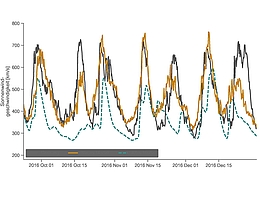June 19, 2021, 10:58 a.m.
In the current “space weather” study, an international team headed by the Central Institute of Meteorology and Geodynamics (ZAMG) and the Institute for Space Research (IWF) of the Austrian Academy of Sciences was able to create static solar wind models using new machine learning – combining algorithms and thus improving space weather forecasting. Significantly. Information from ZAMG.
 (Photo: ZAMG) |
June 17, 2021 – Space weather not only ensures remarkable light processes, also known as polar lights, but can also have a huge impact on our modern technologies. So-called geomagnetic storms, for example, can have a significant impact on power supplies, GPS and other communications systems that our modern society depends on. The expansion of our space programs and the increasing human presence in space, such as the International Space Station or soon again on the Moon, require an accurate prediction of the solar wind. The solar wind is a stream of charged particles that spreads from our central star into space and also hits the Earth’s magnetic field.
Physical models and artificial intelligence
Predicting such solar storms is an unresolved problem even for the most advanced physical models. In fields as diverse as finance, logistics or classical meteorology, AI methods are currently making tremendous progress when it comes to predicting future developments. Therefore, the application of the solar wind is clear, even if space probes generally generate significantly less data compared to the other mentioned regions.
In the new study, researchers from ZAMG and IWF Graz, in collaboration with the US Air Force Research Laboratory and NASA Goddard, looked for a new approach to improving forecasts. ?? We have successfully combined models of the Sun’s magnetic field with algorithms from the field of machine learning in order to predict the effects of the solar wind on Earth much better than was previously possible?? , explains ZAMG researcher Rachel Bailey, first author of the study.
Prediction improved by 20 percent
We had to study measurements and model data for 25 years. But the results more than justify the effort, Bailey continues. The new method reduces the solar wind’s speed error from 99 kilometers per second to 78 kilometers per second and improves forecasts overall by about 20 percent. “The new approach paves the way for improving more complex real-time simulations of the solar wind in the future,” adds IWF researcher and model developer Martin Rees.
The research project is under the supervision of the International Monetary Fund and is funded by the FWF.
Additional information
Study: -> Study link
Related messages on Raumfahrer.net:
Discuss with us on the Raumcon forum:
These: ZAMG

“Social media evangelist. Baconaholic. Devoted reader. Twitter scholar. Avid coffee trailblazer.”







More Stories
Longest jets in the universe discovered – giant particle streams as long as 140 Milky Way galaxies in a row
New method reveals 307 supernova remnants
Snapchat is upping the ante on augmented reality glasses